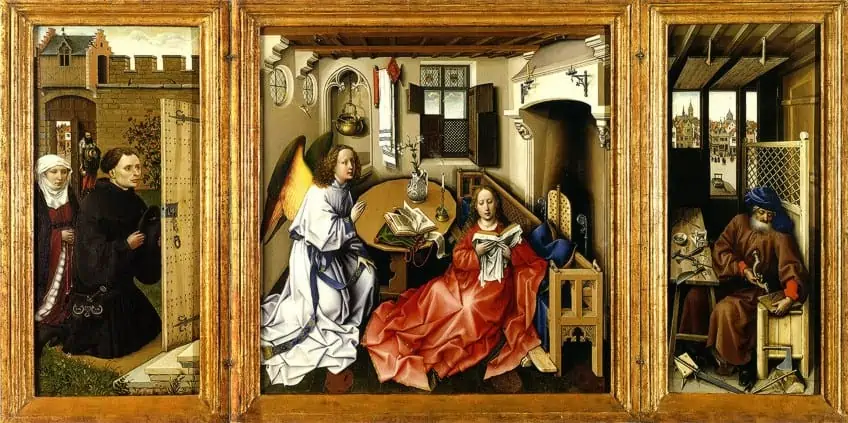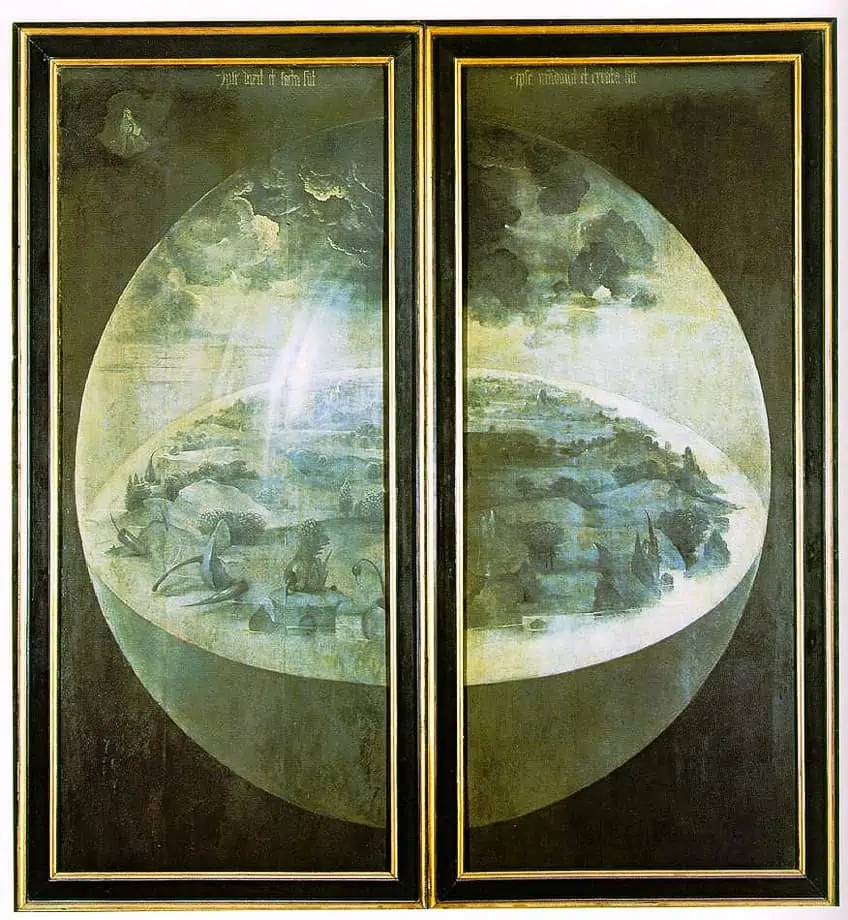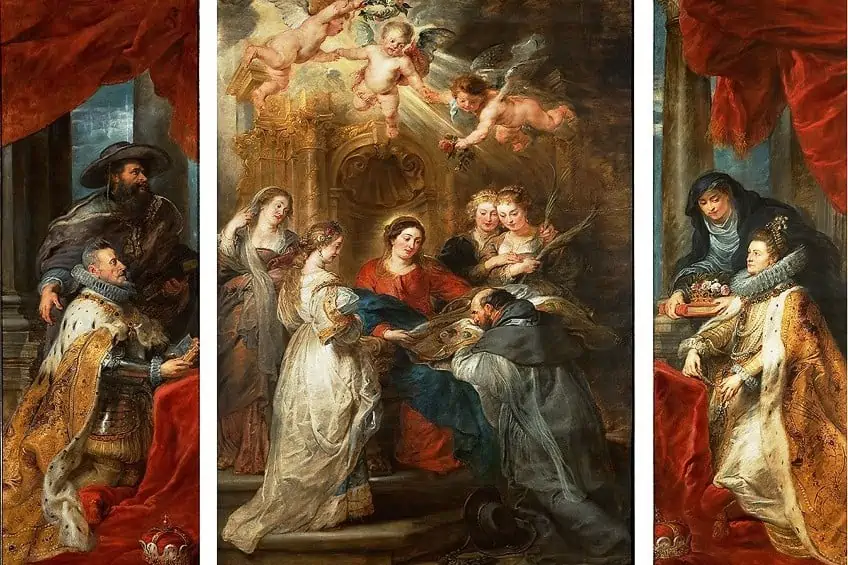What Is a Triptych? – An Introduction to the Best Triptych Artworks
You may have come across artworks produced as part of a series labeled as “triptych”, “polyptych”, or “diptych”, and wondered why this title is used so often to describe artworks made in a series. So, what is a triptych? The term “triptych” has its origin in the Greek language and, like many Greek terms, each term has extended meaning and its own unique journey in art. This article will introduce you to the history of triptych art as well as a few famous triptychs in art history.
What Is a Triptych?
Within an artistic context, the term “triptych” is used to describe a trio of artworks that form a series and usually convey a sequence of events or a series of narratives that relate to each other. A triptych consists of three panels of artwork and is most often used for painting.
Functions of the Triptych in Art
So, why is it important in art? Well, the triptych serves as an efficient way to convey or express a narrative or elements of a painting without convoluting the concept or overwhelming the visual output. The idea of the triptych can function both as one whole artwork when viewed together as well as three separate artworks, each with the ability to stand on its own.
Another benefit of creating a triptych as opposed to a massive large-scale painting meant that the triptych could be transported in parts, which also minimized the risk of damage.
The Triptych Origins
While the term “triptych” first originated as the Greek word triptykhos, meaning three-layered, it crept its way into the art realm since the Middle Ages, which can be understood as the period before the Renaissance. During this period, triptychs conveyed complex religious narratives, which were important decorative and spiritual elements in Christian churches and altarpieces. This was the easiest way to depict religious stories and important scenes that formed the basis of widespread beliefs in Europe.
The most popular subjects depicted in early triptychs of the 14th and 15th centuries were the Madonna with child, better understood as the biblical characters, Mary and the baby, Jesus Christ.
Narratives around Jesus’ life were also significant and were often seen in Christian art depicting scenes of Jesus’ birth, death, and events leading up to his crucifixion. Location-wise, the creation, and installation of triptychs emerged from Byzantine and Celtic churches for private worship uses and relics. Triptychs also feature in early sculpture and were also popular during the Renaissance.

The Gothic era in Europe and other parts of the world saw triptychs installed in cathedrals and as altarpieces in churches. Many triptychs also took the form of stained-glass art as part of the architecture of these religious buildings. The rise in the production of triptych artwork was seen in World War II in the United States when a private citizens’ committee commissioned many artists to produce portable artwork for the purposes of display for the Jewish and Christian troops during religious services. At the end of this project, around 460 triptychs were created by 70 artists, including Nina Wheeler and Hildreth Meiere.
The use of the triptych format was also employed by other religious groups such as Buddhism, Islam, and Judaism.
The triptych became universal for its practicality and affiliation with religious purposes. Following the Renaissance, artworks produced using the triptych format moved away from strictly religious narratives and toward other subjects by artists such as Pablo Picasso and Francis Bacon.
Famous Triptych Artworks
From the Middle Ages to the Contemporary age of art, the triptych format has survived the test of art history and art critics. Below, we will look at a few famous examples of triptych art by artists from different points in art history.
Hilje-j-Sherif Triptych (12th – 18th Century AD) by Halil Kamili and Mahmud
| Artist(s) | Halil Kamili (illuminator; d. 1866), Mahmud (Calligrapher: son of Mustafa; d. 1829) |
| Date | 12th – 18th century AD |
| Provenance | Turkey |
| Period | Ottoman |
| Medium | Wood, gilding, illuminated parchment paper |
| Dimensions (cm) | 95.5 x 65 |
| Where It Is Housed | National Museum of Oriental Art, Rome, Italy |
An early example of a non-Christian triptych is the Hilje-j-Sherif triptych, made between the 12th and 18th centuries from the Ottoman period. The triptych was created entirely out of wood and covered with a thin layer of paper, which was then painted with multiple motifs in three parts. The central panel is said to be the most significant and illustrates the moral and physical qualities of the prophet Muhammed.
The panels on the left and right contain hilyas of the first four caliphs as well as the sons of Hasan, Husayn, and Ali.
The decor on the triptych consists of three leaves with various inscriptions in different characters; thuluth, ta’liq, and naskhi. The decorative elements include floral motifs with shoots in the hatayi style. The hatayi style is a traditional characteristic of Ottoman art that incorporates Chinoiserie decor, which is described as stylized lotus blossoms with leaves and buds in ornate scrolls. Hatayi originated in China in Chatay.
The pointed pediment contains imagery of two sacred locations in Islam; Mecca and Medina, each with the Ka’ba and mosque.
The smaller vase in the center showcasing flowers that are blooming symbolizes the distribution of the virtues of the prophet. The long description of the prophet’s qualities forms part of a literary tradition that begins with the prophet’s biography. This is one such example of a triptych that was created solely for the purposes of veneration since it was believed to possess magical powers embedded in the writing.
The Garden of Earthly Delights (1490 – 1510) by Hieronymus Bosch
| Artist | Hieronymus Bosch (Jheronimus van Aken; 1450 – 1516) |
| Date | 1490 – 1510 |
| Period | Middle Ages to High Renaissance |
| Medium | Oil on oak panels |
| Dimensions (m) | 2.2 x 3.89 |
| Where It Is Housed | Museo del Prado, Madrid, Spain |
This visually complex and meticulously crafted triptych painting by the famous Netherlandish painter, Hieronymus Bosch was executed between 1490 and 1510 and is known as one of the most iconic and celebrated triptychs in the world.
This triptych tells a story inspired by the events in the bible from the creation of the world to the depths of hell accompanied by what some describe this piece to portray, as the temptation of the world.
The outer part of the triptych is also elaborately designed and features a painting of the third day of creation informed by the creation of earthly elements such as light and greenery before the creation of the moon and sun. Bosch also painted a figure believed to be God, who is depicted as a small figure on the upper left of the exterior, seated with a Bible in his lap, engaged in passive creation.

Above the figure, Bosch included a scripture from the book of Psalms: “For he spoke and it was done; he commanded, and it stood fast.”, suggesting that this representation of the Earth as a transparent sphere was an early stage of creation and strayed away from traditional depictions of this scene informed by Christ holding a crystal sphere.
The exterior of the triptych excludes signs of animal and human life and only includes plant life executed in gray hues, which convey a sense of mineral formation.
The interior of the sphere contains the sea with beams of sunlight emanating from the clouds. This quiet heavenly exterior is a preface for the shocking interior of the triptych, which displays scenes of humanity’s lust and the consequence of sin. A German art historian, Hans Belting, suggests that the inner panels convey ideas from the Old Testament of the bible that before the fall of Adam, there existed zero boundaries between good and evil and that humanity was so innocent that it was unaware of the consequences of its nature.

The panel on the left is identified as the joining of Adam and Eve where Eve is being presented to Adam as a gift. One of the many important aspects of this panel lies in Adam’s gaze, which was symbolic of the lustful nature of humanity and the later act of carnal copulation after Eve’s consumption of the forbidden fruit would mark the first sin. Moving to the central panel, one observes that the skyline colors flow into the middle panel with ease suggesting a continuation of a similar degree in the narrative; events that still play out as a result of the events in the Garden of Eden.
The main component here is the garden landscape, which is also the main title of the triptych.
This scene is focused less on the heavenly association with the garden and more on the terrestrial matters involving numerous figures enjoying the sensory pleasures of the garden and each other. The scenes of this panel are ambiguous and allude to both the “playground of corruption” and “spiritual transition” as portrayed by the displays of eroticism. This panel can be read as an “impression of life without consequence”.

The extreme right section of the triptych shows a stark contrast in both color and scenery and depicts Bosch’s version of hell, also seen as the “consequence”. This version of the earth shows what happened to humanity in the aftermath of succumbing to the temptations. Prominent scenes include the tree man, believed to be the self-portrait of the artist himself.
Other references include the seven deadly sins, humans being punished by animals, and musical instruments symbolizing lust as the “music of the flesh”.
The Triptych of St. Ildefonso (1630 – 1632) by Sir Peter Paul Rubens
| Artist | Sir Peter Paul Rubens (1577 – 1640) |
| Date | 1630 – 1632 |
| Period | Baroque |
| Medium | Oil on wood |
| Dimensions (cm) | 352 x 454 |
| Where It Is Housed | Kunsthistorisches Museum Wien, Vienna, Austria |
This famous triptych painting by Flemish diplomat and artist Sir Peter Paul Rubens was commissioned in 1630 and is informed by the legend of a Spanish monk who was taken aback by a blazing light accompanied by a vision of Mary on the throne and two saints. The monk approached the saint and was gifted with a chasuble she personally made.
Rubens had not painted using the triptych method for over a decade and it is unclear why it made its comeback.

On either side of the central panel are the sovereign regents Albert VII and his wife Isabella (the daughter of King Philip II). By this time, it was believed that Albert had already passed away since a 1608 order forbade the use of living people in the center of triptychs. The consistent use of color across the panels joins the artwork nonetheless and presents the image as though it were in one room or scene.
This is seen in the color of the red-draped curtains and the unifying garments of the Virgin Mary.
Battle on the Outskirts of Fengtianfu (1895) by Toshihide Migita
| Artist | Oju Toshihide (1862 – 1925) |
| Date | 1895 |
| Period | Meiji |
| Medium | Triptych woodblock print, ink, and colors on paper |
| Dimensions (cm) | 76.2 x 37 |
| Where It Is Housed | The Patricia & Phillip Frost Art Museum, Miami, United States |
This triptych by Japanese artist, Toshihide Migita, better known as Oju Toshihide was made using the Japanese traditional art-making practice of ukiyo-e printing coupled with the Western style of painting. Oju Toshihide specialized in triptych prints and often portrayed subjects related to the first Sino-Japanese and Russo-Japanese wars.
His works are incredibly famous and highly valued as crucial historical documents.

Many of Toshihide Migita’s works have been published in magazines and newspapers since 1877 and he was also renowned for his talent in creating portraits of kabuki actors. This triptych shows us a glimpse of a battle about to occur as the opposition leader waves his sword forward, commanding his men, who are approaching from the left panel.
This triptych is most likely a scene from the Sino-Japanese war.
Dropping a Han Dynasty Urn (1995) by Ai Weiwei
| Artist | Ai Weiwei (1957 – Present) |
| Date | 1995 |
| Medium | Photography; three silver gelatin prints |
| Dimensions (cm) | 148 x 121 |
| Where It Is Housed | Guggenheim Museum Bilbao |
Referenced by the artist as “a cultural readymade”, this incredibly shocking work was created by the Chinese activist and Contemporary artist, Ai Weiwei in 1995 as part of an exhibition, Art and China after 1989, held at the Guggenheim Museum Bilbao.
This photographic triptych is famous for its shock effect and the incredible statement made by Weiwei as he shatters a 2000-year-old Han Dynasty urn, which was valued at a significant price.
Not only was the ceremonial urn of hefty value, but it was also symbolically and culturally important since the Han Dynasty was a period of rapid development in Chinese civilization. Weiwei’s act of shattering the urn for all to see, in three parts, was likened to his demolishing the cultural heritage of China. This is also considered an act of freedom from the heritage of the artist and a bold statement on his independence and creativity.
The transition of the triptych as an homage to religious and cultural narratives to the opposition to its invisible shackles is evident and profound in this work.
Why Invest in a Triptych?
There are a few reasons already mentioned as to why triptych art is so great but below, we will be taking a look at a few more reasons why you should consider investing either your time or money into making or purchasing a triptych.
- As seen in many triptychs, an artist can maximize their talents in gradation and color to help guide the viewer’s eye from one scene to another in a triptych composition. Triptychs make for great experiments with color and as a viewer or keen buyer, a triptych is perfect for viewing a large-scale work, especially if the composition is busy.
- All great things come in threes and triptychs are one of them. Triptych paintings carry a Middle-Age-Renaissance aesthetic to them and offer the viewer a challenge to form meaning from the artwork.
- Aside from being aesthetically pleasing, one can space out the three panels as far apart as possible, which makes for interesting curation. In terms of art decor, triptychs are a great investment especially if you are looking to cover some wall space and get a good return on your money.
There are so many benefits to making and investing in triptych art and these are just a few to mention. The evolution of triptychs in art from religious iconography artwork and historical documentation to a format for Contemporary reinterpretation just goes to show the many ways that one can adopt and mold the format of the triptych to create powerful works of art.
Take a look at our triptych webstory here!
Frequently Asked Questions
What Is a Triptych?
A triptych is a trio of panels or artworks that, when viewed together, relay one narrative or story. A triptych is considered a set of three artworks in a sequence to express a series of related events.
What Are the Most Famous Triptych Examples?
The most famous triptych example is considered to be Il Trittico Stefaneschi from the Proto-Renaissance era, painted in 1330 by the Italian artist Giotto di Bondone. Alongside this is the triptych The Garden of Earthly Delights (1490 – 1510) by Hieronymous Bosch, as well as Mérode Altarpiece (c. 1427 – 1432) by Robert Campin.
What Is the Purpose of Triptych Art?
The purpose of triptych art is normally to convey a narrative or sequence of events in three parts to help the viewer understand the greater narrative. Triptychs usually consist of a beginning, middle, and end. Other functions of creating triptych art include illustrating transitional events, showcasing gradation or painting techniques, and offering different perspectives on one subject.
Jordan Anthony is a Cape Town-based film photographer, curator, and arts writer. She holds a Bachelor of Art in Fine Arts from the University of the Witwatersrand, Johannesburg, where she explored themes like healing, identity, dreams, and intuitive creation in her Contemporary art practice. Jordan has collaborated with various local art institutions, including the KZNSA Gallery in Durban, the Turbine Art Fair, and the Wits Art Museum. Her photography focuses on abstract color manipulations, portraiture, candid shots, and urban landscapes. She’s intrigued by philosophy, memory, and esotericism, drawing inspiration from Surrealism, Fluxus, and ancient civilizations, as well as childhood influences and found objects. Jordan is working for artfilemagazine since 2022 and writes blog posts about art history and photography.
Learn more about Jordan Anthony and about us.
Cite this Article
Jordan, Anthony, “What Is a Triptych? – An Introduction to the Best Triptych Artworks.” artfilemagazine – Your Online Art Source. October 14, 2022. URL: https://artfilemagazine.com/what-is-a-triptych/
Anthony, J. (2022, 14 October). What Is a Triptych? – An Introduction to the Best Triptych Artworks. artfilemagazine – Your Online Art Source. https://artfilemagazine.com/what-is-a-triptych/
Anthony, Jordan. “What Is a Triptych? – An Introduction to the Best Triptych Artworks.” artfilemagazine – Your Online Art Source, October 14, 2022. https://artfilemagazine.com/what-is-a-triptych/.



